

¡¡
¡¡
¡¡
¡¡
¡¡
|Abstract|Algorithms|Results|Conclusion|References|
Amateur home video
makers are unaware of the principles of cinema grammar. The videos they shoot
are meant to convey an intent. But often, their inexperience, ignorance, lack of
editing skills, or the limitations of the means of video capture they have at
their disposal belie their intentions. Intent delivery techniques introduced in
this paper can aid such footage and convey a range of evident intents as well as
those not intended initially, by using principles of cinema grammar, aesthetics
and video analysis. In this paper, a general approach for video intent delivery
is described with respect to a brief catalog of the intentions of the
cinematographer and editor. Then four basic examples of delivering intents:
cheer, serenity, gloom and excitement through pieces of raw footage are
presented. Thus, we seek the theoretical support from video grammar and
cinematic rules, in order to model computable features for repurposing home
videos.
¡¡
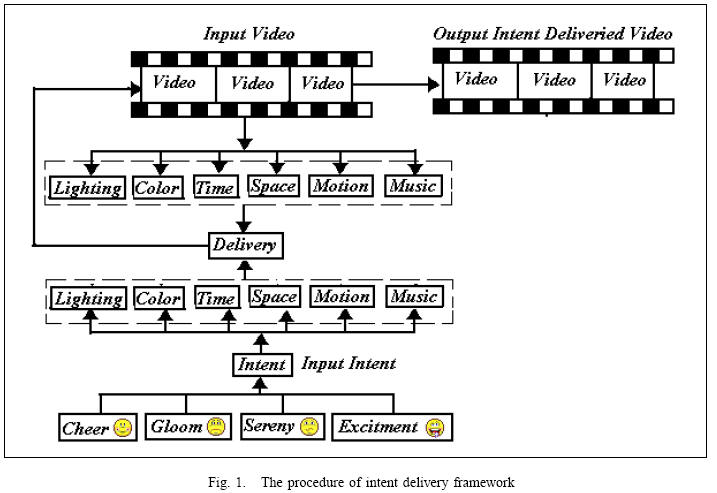
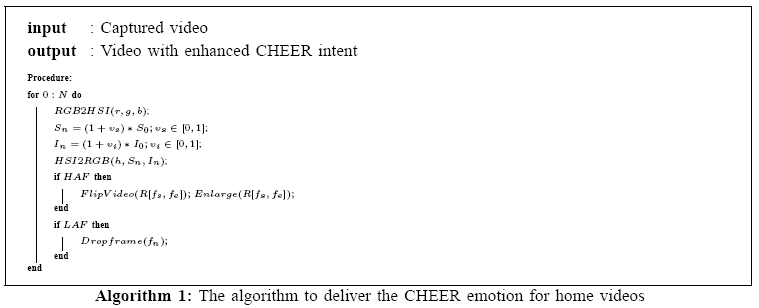
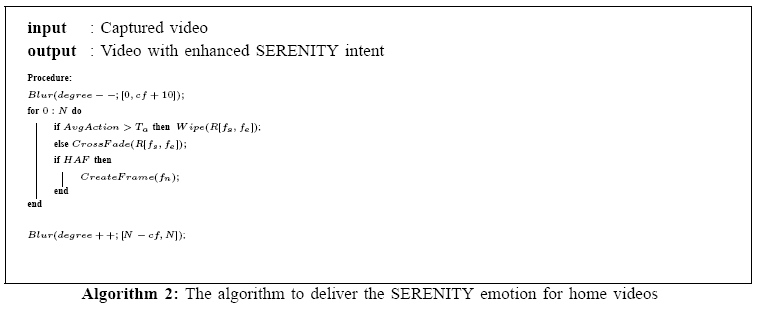
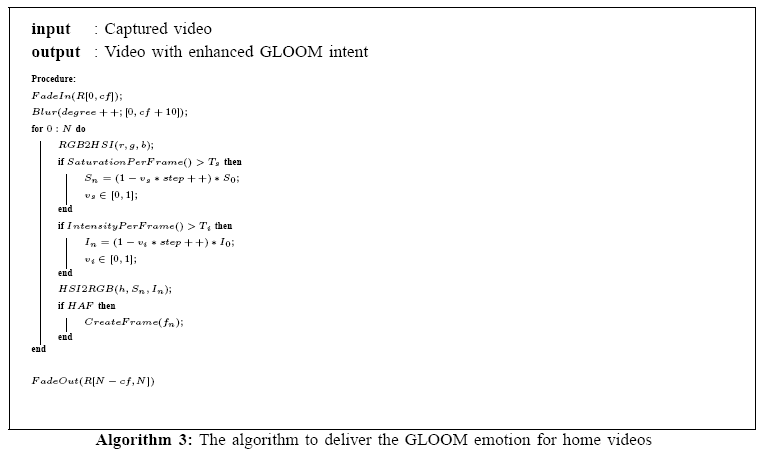
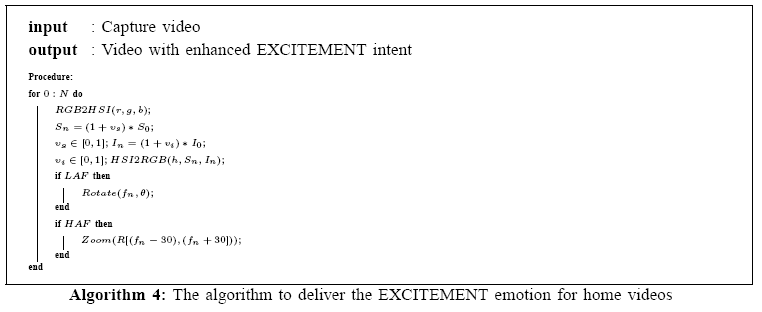
|
ORIGINAL CLIPS |
CHEER |
GLOOM |
SERENITY/ TIME PASSAGE |
EXCITEMENT |
| Excite-nadia | ||||
| Excite-wagon | ||||
| Excite-walk | ||||
This paper imparts users' intent to an
input video clip without requiring the user to be proficient either with
computers or with cinema grammar. It uses simple video processing tools on
raw video to generate video clips that conform to cinema grammar rules.
Currently it only relies on some simple low level properties of the video.
It does not require any complicated semantic understanding of the video; The
user may have to use the
individual image processing options to get the video intents he wants. We
select the computable features from human intents and digital videos, thus
we are successful in reducing the dependence on ad-hoc method in media
aesthetics.
¡¡
[1] D. Seligmann, ¡°Automated generation of
intent-based 3d illustrations,¡± in Proc. of ACM SIGGRAPH, 1991, pp.
123¨C132.
[2] Sony Corporation, Operating Instructions of Sony Digital Video
Camera Recorder:DCR-PC101E, Sony, 2002.
[3] Wei-Qi Yan and Mohan S Kankanhalli, ¡°Detection and removal of
lighting and shaking artifacts in home videos,¡± in Proc. of ACM
Multimedia, Jan-Les-Pan, France, Nov 2002, ACM Multimedia, pp. 107¨C116.
[4] Chitra Dorai and Sevetha Venkatesh, ¡°Computational media aesthetics:
Finding meaning beautiful,¡± IEEE multimedia, vol. 8, no. 4, pp. 10¨C12,
Oct 2001.
[5] Mulhem Philippe, Kankanhalli Mohan, and Ji Yi, ¡°Pivot vector space
approach for audio-video mixing,¡± IEEE Multimedia, pp. 28¨C40, April
2003.
[6] Marc Davis, ¡°Editing out video editing,¡± IEEE multimedia, vol. 10,
no. 2, pp. 54¨C64, April-June 2003.
[7] Brett Adams, Svetha Venkatesh, and Ramesh Jain, ¡°Imce: Integrated
media creation environment,¡± in Proc. of ICME04, Taiwan, June. 2004.
[8] Dinh Phung, Sevetha Venkatesh, and Chitra Dorai, ¡°Hierarchical
topical segmentation in instructional films based on cinematic
expressive functions,¡± in ACM Multimedia 2003, Berkeley, CA, USA, Nov
2003, ACM Multimeida, pp. 287¨C 290.
[9] Stephen Prince, Movies and meaning: an Introduction to Film, Allyn
and Bacon, Boston,USA, 1997.
[10] Zettl Herbert, Sight, sound, motion: applied media aesthetics (the
3rd edition), Wadsworth Publishing Company, 1999.
[11] Gonzalez R.C. and Woods R.E., Digital image processing,
Addison-Wesley, 1992-1993.
[12] Tekalp A. M., Digital Video Processing, Prentice Hall, 1995.
[13] Truong B, Venkatesh Sevetha, and Dorai Chitra, ¡°Application of
computational media aesthetics methodology to extracting color semantics
in film,¡± in Proc. of ACM Multimedia 2002, Juan Les Pins, France,
Dec.1-6 2002, ACM Multimedia.
[14] Brett Adams, Chitra Dorai, and Svetha Venkatesh, ¡°Automated film
rhythm extraction for scene analysis,¡± in Proc: IEEE International
Conference on Multimedia and Expo 2001, Tokyo,Japan, Aug 2001, ICME, pp.
1192¨C1195.
[15] Brett Adams, Chitra Dorai, and Svetha Venkatesh, ¡°Study of shot
length and motion as contributing factors to movie tempo,¡± in 8th ACM
International Conference on Multimedia, Los Angeles, California, Nov.
2000, pp. 353¨C355.
[16] Brett Adams, Chitra Dorai, and Svetha Venkatesh, ¡°Role of shot
length in characterizing tempo and dramatic story sections in motion
pictures,¡± in IEEE Pacific Rim Conference on Multimedia 2000, Sydney,
Australia, December 2000, pp. 54¨C57.
[17] Andrew Salway and Mike Graham, ¡°Extracting information about
emotions in films,¡± in ACM Multimedia 2003, Berkeley,CA, USA, Nov 2003,
ACM Multimedia, pp. 299¨C302.
[18] Robert Plutchik and Henry Kellerman, Emotion theory, research and
experience: the measurement of emotions, vol. 4, Academic Press Inc,
1989.
[19] Girgensohn A., Boreczky J., Chiu P., Doherty J., Foote J.,
Golovchinsky G., Uchihashi S., and Wilcox L., ¡°A semi-automatic approach
to home video editing,¡± in CHI letters, Feb. 2000, vol. 2, pp. 81¨C89.
[20] Parkes A. P., ¡°The prototype cloris system: describing, retrieval
and discussing video stills and sequences,¡± Information Processing and
Management, vol. 25, no. 2, pp. 171¨C186, 1998.
[21] Nack F. and Parkes A., ¡°Auteur: The creation of humourous scenes
using automated video editing,¡± in Proc.of IJCAI-95 Workshop on AI
Entertainment and AI/Alife, Montreal, Canada, Aug. 1995.
[22] Ronald Baecker, Alan J. Rosenthal, Naomi Friedlander, Eric Smith,
and Andrew Cohen, ¡°A multimedia system for authoring motion pictures,¡±
in ACM Multimedia, Boston, MA,USA, 1996, pp. 31¨C42.
[23] Bailey B.P., Konstan J.A., and Carlies J.V., ¡°Demais: Designing
multimedia applications with interactive storyboards,¡± in Proc. of ACM
Multimedia 2001, Ottawa, Ontario, Canada, Sep 2001, pp. 241¨C250.
[24] Stefan Sharff, The elements of Cinema (Toward a theory of
cinesthestic impact), Columbia University Press, 1982.
[25] GARAGE, http://garage.sims.berkeley.edu.
[26] Marc Davis, ¡°Knowledge representation for video,¡± in Proc. of
Twelfth National Conference on Artiactial Intellegence (AAAI- 94),
Seattle, 1994, pp. 120¨C127, AAAI Press.
[27] Brett Adams, Svetha Venkatesh, and Chitra Dorai, ¡°Finding the beat:
an analysis of the rhythmic elements of motion pictures,¡± International
Journal of Image and Graphics, vol. 2, no. 2, pp. 215¨C245, 2002.
[28] Brett Adams, Chitra Dorai, and Svetha Venkatesh, ¡°Formulating film
tempo - the Computational Media Aesthetics methodology in practice,¡± in
Media Computing: Computational Media Aesthetics. Kluwer Academic
Publishers, 2002.
[29] Brett Adams, Chitra Dorai, and Svetha Venkatesh, ¡°Towards automatic
extraction of expressive elements from motion pictures: Tempo,¡± IEEE
Transactions on Multimedia, vol. 4, no. 4, Dec. 2002.
[30] D. Arijion, Grammar of the film language, Silmon James, 1976.
[31] Adams B., Mapping the Semantic Landscape of Film: Computational
Extraction of Indices through Film Grammar, Ph. D. thesis, Curtin
University of Technology, Australia, 2003.
[32] Phung D. Q., Venkatesh S., and Dorai C., ¡°On extraction of thematic
and dramatic functions in educational films,¡± in IEEE International
Conference on Multimedia and Expo, Baltimore, New York, USA, July 2003.
| Abstract | Algorithms | Results | Conclusion | References |
(c) Copyright Reserved
DIVA Lab@SoC/NUS, Singapore,117543
Email: dcsyanwq@{yahoo,hotmail}.com
Latest Update: 2005-06-20